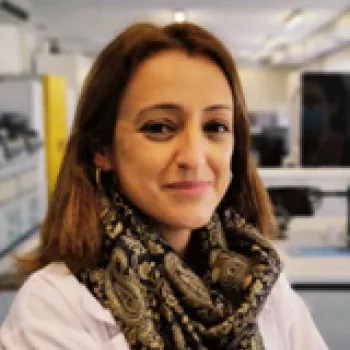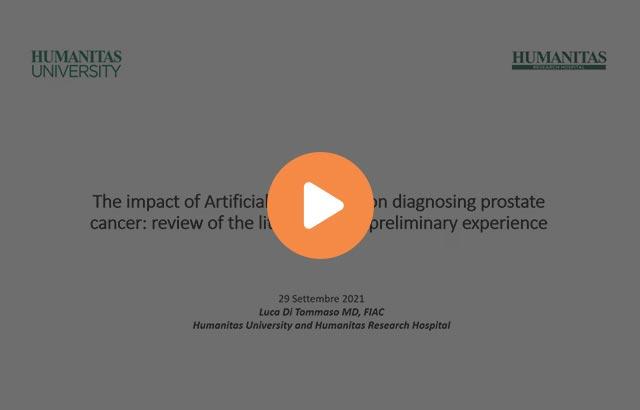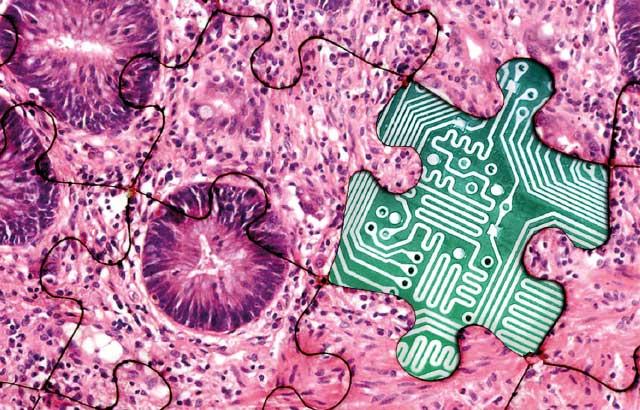
The Augmented Pathologist: Empowering for Better Patient Care

The augmented pathologist works synergistically with AI, has no fear of being substituted and has the pride of being part of an empowered generation that envisions better care for our patients.
Trying to emerge from a prolonged pandemic period, under the shadow of a global-scale environmental, social/political, and economic crisis, populations are hoping for disruptive solutions to regain balance. In addition to these constraints, pathologists keep being challenged by increasing quality demands, high-speed innovation, and health inequities, including manpower shortage and/or lack of general resources. The possibility of introduction of artificial intelligence (AI) tools for clinical usage rises as the light at the end of the tunnel for many 1,2, generating new movements that are unifying the community 3.
After some years of disbelief in morphology, ironically, AI recovers the enthusiasm on the magnificent content carried by a hematoxylin-eosin (H&E) stained tissue in the so-called next-generation morphology. The old fashion H&E is empowered since its transformation in the whole slide image (WSI) reveals an overwhelming amount of information, difficult to manage by the human brain to some extent. However, this information seems relevant for patient management, epitomizing the meaning of the precision medicine concept.
It is undeniable the benefit that AI can carry to the augmented pathologist, empowering us to perform more accurate diagnoses 4. Both senior pathologists and pathology residents can benefit from the introduction of AI tools for diagnosis, prognosis, and therapy selection, provided that the advantages and limitations of their usage are understood 5.
Among other positive aspects, AI tools have the possibility to be implemented in a pathology laboratory without a tremendous logistic investment, once the digital pathology workflow is in place 6. Adopting the digital workflow transcends the benefits of producing the WSI for sharing and AI analysis. After understanding how simple it may be to increase efficiency, quality, and safety (namely environmental safety/preservation) in the laboratory workflow, there is not a single reason that justifies delaying in the adoption of the digital management of the pathology laboratory, since it represents a relevant improvement in health care 6,7.
There is a key role for educational opportunities at this moment, including those related to validation procedures/quality control, adoption of new types of follow-up-based controls, and standardization of laboratory procedures that will support the sustainable usage of AI 8. This short-term strategy on continuous medical and technical education should ideally be complemented by a long-term educational strategy. Medical students and pathology residents will also benefit from an updated curriculum on technological developments allowing them to lead more automated laboratories in the near future.
The generation of data by the AI usage in patients’ samples will surely increase the demand for the pathologist intervention and increase the complexity of the report in a first phase. Nevertheless, the augmented pathologist that submits to this educational, evolutional and even disruptive process, will certainly become the one who is also ready to contribute building up the modern science knowledge based on explanation of the phenomena, understanding the new challenges on disease taxonomy, and embracing the possibility of the integrative dimension of pathology.
The augmented pathologist works synergistically with AI, has no fear of being substituted and has the pride of being part of an empowered generation that envisions better care for our patients.
About the presenter

Dr. Catarina Eloy is the Head of the Pathology Laboratory of IPATIMUP/ Researcher at i3S/ Affiliated Professor of Medical Faculty of The University of Porto. She is also the former President of the European Society for Digital and Integrative Pathology and Vice-president of the Portuguese Society of Anatomic Pathology.
Dr. Eloy received her MD in 2003 from the Medical Faculty of The University of Porto with a specialization in Pathology
Dr. Eloy has been a researcher since 2006 at the cancer signaling & metabolism of i3S/Ipatimup and received a Ph.D. in Thyroid cancer in 2012 by the Medical Faculty of The University of Porto.
Dr. Eloy has 70 publications and three academic and scientific awards/distinctions.
References
- Sarwar, S., Dent, A., Faust, K. et al. Physician perspectives on integration of artificial intelligence into diagnostic pathology. npj Digit. Med. 2, 28 (2019). https://doi.org/10.1038/s41746-019-0106-0
- Salto-Tellez M, Maxwell P, Hamilton P. Artificial intelligence-the third revolution in pathology. Histopathology. 2019 Feb;74(3):372-376. doi: 10.1111/his.13760. PMID: 30270453.
- Eloy C, Zerbe N, Fraggetta F. Europe Unites for the Digital Transformation of Pathology: The Role of the New ESDIP. J Pathol Inform. 2021 Mar 12;12:10. doi: 10.4103/jpi.jpi_80_20. PMID: 34012714; PMCID: PMC8112336.
- Polónia A, Campelos S, Ribeiro A, Aymore I, Pinto D, Biskup-Fruzynska M, Veiga RS, Canas-Marques R, Aresta G, Araújo T, Campilho A, Kwok S, Aguiar P, Eloy C. Artificial Intelligence Improves the Accuracy in Histologic Classification of Breast Lesions. Am J Clin Pathol. 2021 Mar 15;155(4):527-536. doi: 10.1093/ajcp/aqaa151. PMID: 33118594.
- Serag A, Ion-Margineanu A, Qureshi H, McMillan R, Saint Martin MJ, Diamond J, O'Reilly P, Hamilton P. Translational AI and Deep Learning in Diagnostic Pathology. Front Med (Lausanne). 2019 Oct 1;6:185. doi: 10.3389/fmed.2019.00185. PMID: 31632973; PMCID: PMC6779702.
- Fraggetta, F.; L’Imperio, V.; Ameisen, D.; Carvalho, R.; Leh, S.; Kiehl, T.-R.; Serbanescu, M.; Racoceanu, D.; Della Mea, V.; Polonia, A.; Zerbe, N.; Eloy, C. Best Practice Recommendations for the Implementation of a Digital Pathology Workflow in the Anatomic Pathology Laboratory by the European Society of Digital and Integrative Pathology (ESDIP). Diagnostics 2021, 11, 2167. https://doi.org/10.3390/diagnostics11112167
- Eloy C, Vale J, Curado M, Polónia A, Campelos S, Caramelo A, Sousa R, Sobrinho-Simões M. Digital Pathology Workflow Implementation at IPATIMUP. Diagnostics. 2021; 11(11):2111. https://doi.org/10.3390/diagnostics11112111
- Schömig-Markiefka, B., Pryalukhin, A., Hulla, W. et al. Quality control stress test for deep learning-based diagnostic model in digital pathology. Mod Pathol 34, 2098–2108 (2021). https://doi.org/10.1038/s41379-021-00859-x
Related Content
Leica Biosystems Knowledge Pathway content is subject to the Leica Biosystems website terms of use, available at: Legal Notice. The content, including webinars, training presentations and related materials is intended to provide general information regarding particular subjects of interest to health care professionals and is not intended to be, and should not be construed as, medical, regulatory or legal advice. The views and opinions expressed in any third-party content reflect the personal views and opinions of the speaker(s)/author(s) and do not necessarily represent or reflect the views or opinions of Leica Biosystems, its employees or agents. Any links contained in the content which provides access to third party resources or content is provided for convenience only.
For the use of any product, the applicable product documentation, including information guides, inserts and operation manuals should be consulted.
Copyright © 2025 Leica Biosystems division of Leica Microsystems, Inc. and its Leica Biosystems affiliates. All rights reserved. LEICA and the Leica Logo are registered trademarks of Leica Microsystems IR GmbH.


